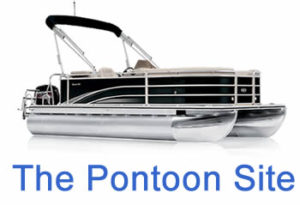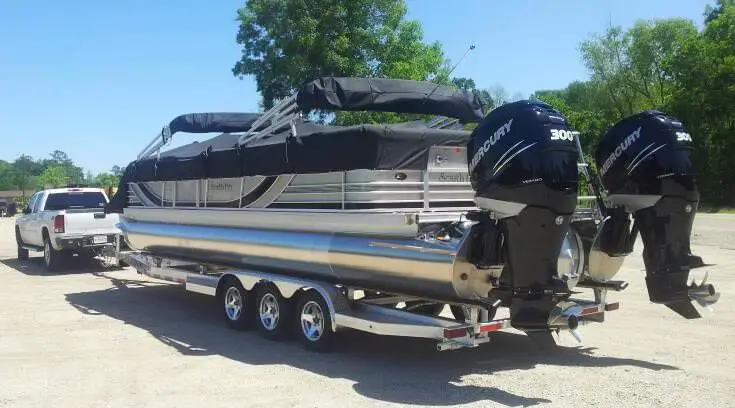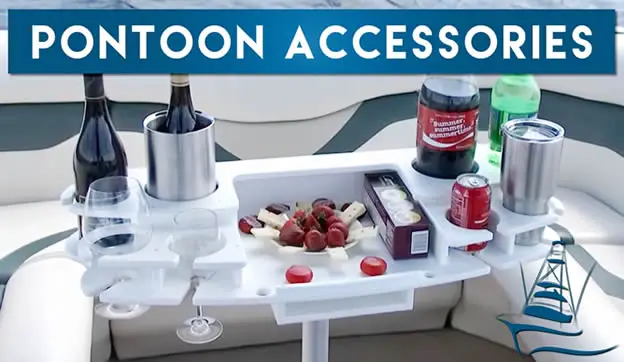When it comes to pontoon boat towing, you need to be well versed with the methods required to safely transport your boat. This will help you to avoid damaging your boat and, consequently, incurring repair costs.
Towing your boat rather than mooring it in an expensive marina helps you cut down on boat expenses but how do you do it?
Contents
- 20 tips for towing and trailering a pontoon boat
- Three things to check on the trailer before you move off – the pre-trip checklist
- Two Key trailer weight restrictions to check before you begin towing
- Two Essential safety precautions you must observe
- One Important aspect to trailering a pontoon boat guide
- Five steps for safely and effectively towing a pontoon boat
- Seven essentials for loading a pontoon boat onto a trailer safely
- How to load a pontoon boat on a trailer by yourself
- How to launch a pontoon boat by yourself in 5 simple steps
- Final thoughts on trailering & towing a pontoon boat
20 tips for towing and trailering a pontoon boat
When towing a pontoon boat you must always ensure you have trailered your boat securely.
- Perform safety checks before embarking.
- Secure loose items in the pontoon so they don’t fly off in transit. Leave enough space between trailer and vehicle for tight right turns.
- Keep your speed down while towing.
- If it’s your first time towing a pontoon boat first practice maneuvers, such as reversing and turning, locally in a large safe area before your trip.
The very first thing you need to do is to make sure that you have the correct type of trailer and, probably more importantly, you must have the right sized trailer for your pontoon boat.
Before you embark on your journey you must make sure your pontoon boat is correctly trailered to avoid possible damage. This is often a challenge for most pontoon owners. However, we are here to help.
This article will explain, in detail, how you can securely tow your pontoon boat from the first step to the last, even showing you how to launch the boat safely and on your own.
Let’s dive right in.
Three things to check on the trailer before you move off – the pre-trip checklist
Performing a quick inspection on both the trailer and the towing vehicle is a crucial and compulsory step that every responsible boat owner must carry out. Failing to take a few short moments to perform safety checks could mean the difference between enjoying a day on the water or spending it answering police questions about why your boat came loose on the highway!
Follow these initial safety checks:
- Lights.
- Tires.
- Trailer hitch.
1. Check the trailer lights
It is illegal to drive a trailer with faulty or non-working lights. It is therefore very important to check your lights before going on the road to avoid problems.
Don’t assume your lights are working just because they were working the last time you used your vehicle.
Bulbs are cheap and easy to replace. It’s not so easy to replace the rear of your boat should a car jack into it because it didn’t know you were braking.
2. Check the tires
Trailer tires should be checked regularly to determine whether they are in good condition and at the correct pressure. They should always be checked before a journey.
If they are worn out replace them. Worn tires will cause your trailer to skid when you break and sway while driving on the road.
Don’t load your boat onto a trailer with tires that are not at the correct pressure. Fix the pressure first even if that means a journey with an empty trailer to a gas station to access an air compressor first.
If your trailer tires are tubeless this will not be a problem but you should still make sure they are in good working order.
Always have at least one spare tire that is ready to use in case of a puncture or blowout.
3. Check the trailer hitch
Use chains or another securing method to lock your trailer in place.
Having a backup method in place (and being used at the same time) will come in handy in case the initial securing method fails.
Two Key trailer weight restrictions to check before you begin towing
Make sure your trailer can handle the weight of your pontoon boat.
Here is a quick guide to help you determine if your current trailer can handle your pontoon boat. Of course you need to know the weight of your pontoon boat to use this table correctly.
1. Check the trailer weight load
The load restrictions of this table are approximations only. The figures are based on a comparison of different trailers from different manufacturers.
To ensure you get the exact specifications and recommend load capacity of your specific trailer contact the manufacturer of your trailer.
| Capacity | No.Axles | Trailer Length | Trailer Width | Weight |
| 1000 lbs | 1 | 15′ 4″ | 62″ | 295 lbs |
| 1500 lbs | 1 | 15′ 4″ | 62″ | 305 lbs |
| 2000 lbs | 1 | 17′ 2″ | 88″ | 492 lbs |
| 2450 lbs | 1 | 18′ 2″ | 96″ | 522 lbs |
| 2999 lbs | 1 | 18′ 2″ | 96″ | 625 lbs |
| 350 lbs | 1 | 19′ 8″ | 96″ | 677 lbs |
| 5000 lbs | 1 | 20′ 8″ | 96″ | 933 lbs |
| 7000 lbs | 1 | 27′ 9″ | 96″ | 1512 lbs |
Please remember these numbers are estimates only and you are advised to seek the exact weight load capacities of your particular trailer from its manufacturer.
2. Check the combined towing weight
The average weight of a pontoon boat is 2,200lbs while the average trailer weighs 1,200 lbs.
Make sure your vehicle, and your vehicle’s two bar or hitch system, can tow this load safely.
This means you should know the weight of your boat beforehand to determine whether your towing vehicle can comfortably pull the combined weight.
The best way to find out the weight of your boat is to get in touch with the manufacturer through their respective website or look at the owner’s manual if you have one.
You will also need to know the towing capacity of your hitch system and your vehicle.
After determining the weight of your boat, combine it with the trailer’s weight to ensure the total towing weight is within acceptable limits for your vehicle and towing system.
Never exceed the towing weight limit or you run the very real and serious risk of having an accident and damaging both your vehicle and your boat and maybe even causing severe injury to yourself or others.
Two Essential safety precautions you must observe
1. Check whether your insurance is valid
Often, your insurance can be invalidated when you attach a trailer to your vehicle.
You need to review your boat and vehicle insurance to make sure you are insured for both trailering and towing. If you are in doubt contact your insurer.
If your current insurance does not cover the use of a trailer a small additional premium payment should be enough to add that cover.
If you plan on boating in another state then it will be an advantage if you have some form of national insurance cover since the laws change from state to state. This will ensure your insurance remains valid no matter where you are.
Always check and confirm your insurance policy and documents before towing as this not only ensures you are covered but gives you all relevant information needed if you are stopped by law enforcement. If you are stopped it could mean a long delay if the police officer has to verify for himself/herself that you adhering to legal requirements.
2. Secure all loose items on your boat
This is an often overlooked safety check.
Before loading your boat make sure everything in the boat is secured including all pontoon boat accessories. Loose life jackets, clothes, towels etc. are often left on the seating of the boat which is fine when the boat is in the water but these items are likely to be dislodged and lost when you are travelling at speed on the roads. They could also cause accidents if they hit another vehicle.
This check is especially important when you are returning home as this is when it is mostly likely you will have loose items on the boat.
One Important aspect to trailering a pontoon boat guide
1. Firmly and securely strap your pontoon to the trailer
Failing to securely strap a boat to its trailer is the most common cause of boat-related road accidents.
People who have failed to secure their boats to their trailers properly, and are very lucky, have had their boats crash off their trailers outside their homes. Those who are less lucky have had this happen on a busy highway and caused injuries to other road users.
An improperly secured pontoon boat can also break free from its trailer bindings and ride on top of its towing vehicle especially if the vehicle breaks suddenly or slows down quickly while approaching lights. This causes damage not just to the boat but also to the vehicle for a double repair bill.
Ensuring that your boat is correctly strapped to the trailer will avoid such accidents.
Ensure you double check to make sure your boat is firmly and thoroughly secure before you embark on your journey. If in doubt – secure it more!

Five steps for safely and effectively towing a pontoon boat
Now that you have your pontoon boat securely trailered it’s time to move the boat.
Driving with a trailered pontoon boat also requires you take some preparatory steps before embarking on your journey. Below are guidelines for driving with your trailered pontoon boat so you arrive at your destination safely and with an undamaged boat.
1. Practice makes perfect
Once you have completed your safety checks, have your boat secured on its trailer with the trailer attached to your vehicle you might be tempted to think that you are good to go seeing that you are already familiar with your vehicle and your trailer. But this is not the case.
It is a completely different towing experience when you add thousands of pounds of extra weight from a very large boat.
You should, therefore, have a few practice sessions towing your boat before attempting a long journey.
Make a few short local towing trips ensuring you take corners and are not just using straight roads. If you get into difficulty it is much easier to sort the situation out when you are a few blocks from home and not in a different state.
So, practice over short distances first so that you are confident that you’re ready to handle towing over long distances.
This practice will also help you identify how your trailer and vehicle behave while towing and if any modifications are needed.
2. Turning, reversing and parking
During your short practice sessions you should emphasize more practice on maneuvers rather than straight driving. Practice turning especially tight right turns, as well as k-turns, backing-up, parallel parking and braking.
Practice will make you comfortable driving on the road and also help you better accommodate other drivers. It will also give you confidence in your ability to get out of tight situations such as when you make a wrong turn and end up facing a closed-off road, for example.
Practicing will also allow to identify if you left enough space between the boat trailer and your vehicle. You need adequate space for making tight right turns as the front of the trailer and the back of your vehicle will come very close.
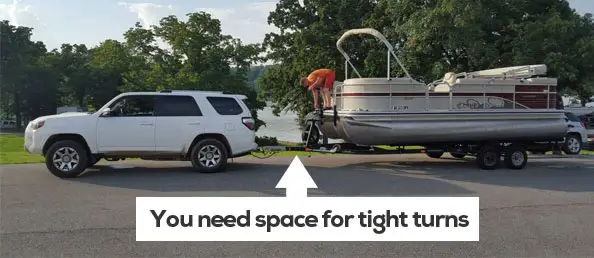
3. Do not exceed towing speed limits
Speed limits will vary from state to state. Checking your speed limit is, therefore, essential.
However, do try to hit the set speed limits when towing a pontoon as the increased weight will make slowing down take longer.
It helps more to drive comfortably than to drive fast. After all, whether you drive fast or slow, the lake is going nowhere. So, leave early and give yourself plenty of time to reach your destination driving at reasonable speeds.
4. Make sure you can make a safe stop
Making a stop with a trailer at the back is, obviously, not the same as stopping without one.
Always consider how long it will take you to stop and keep a safe distance from the vehicles in front of you. This is another good reason to keep your speed down.
Stepping on the brakes suddenly can make your trailer jerk forward or even sway dangerously.
You should be driving in a way that lets you apply gradual force to the brakes in order to bring your load under control safely.This can only happen if you have left a large enough distance between you and the vehicle in front of you and you are travelling at slower speeds.
5. Take regular breaks on long towing trips
Being on the road for a long time is tiring. You can get tired and even forget you’re towing your pontoon especially if you are not used to it.
Make sure to break after around three or four hours of driving to enable your body and mind to relax and to remind yourself you have a load at the back.
Forgetting that you are towing are heavy and large boat can be quite dangerous for you and other drivers but it is more common than you may imagine. It is all too easy to inadvertently increase your driving speed or abruptly change lanes without considering the extra length at the back of your vehicle and the extra weight you are carrying.
It is therefore wise to take regular breaks to clear your head and regain your focus.
Taking a break will also give you time to perform a few quick safety checks on your vehicle, trailer and boat just to make sure everything is secure and no problems have developed on the road.
Seven essentials for loading a pontoon boat onto a trailer safely
Here are a few tips to help ensure you load your pontoon onto your trailer in a safe manner.
1. Use the wind to your benefit
The wind can be of great help when you’re loading your boat but only if you know how to take advantage of it.
If you can have your boat start upwind and put it parallel to your trailer, you can actually use the wind to help you push the boat to the trailer.
2. Make use of a boat hook
A boat hook helps to put your boat in a straight position when you want to load it onto your trailer for your homeward journey.
A boat hook is designed to to help with both docking and undocking a boat but it can be used in exactly the same manner to also help with loading the boat on a trailer.
3. Keep your trailer in shallow water
Your trailer should not be too submerged in the water.
A pontoon boat has a shallow draft and can access very shallow water areas so take advantage of that. If you try to load your boat with the trailer full submerged you may have a hard time getting the boat lined up to get it onto the trailer especially when it is windy.
4. Watch for slippery ramps
Avoid completely wetting your vehicle tires.
Remember most ramps have moss. When you combine moss with wet tires, the surface becomes slippery. As a result, your vehicle may not be able to pull the trailer especially if your trailer tires spin when you attempt to pull your boat out of the water.
5. Use guide rails
A great way to safely load a pontoon boat is with the aid of guide rails. Guide rails will help you gauge the appropriate depth to submerge your trailer.
The rails will also help you straighten up your boat when loading it. Setting your boat straight makes it easier to slide it right into the trailer.
6. Empty the boat of passengers
Ensure everyone leaves the boat before loading it.
If it is not possible to have your passengers disembark, then, at least, have them move from the aft of the boat to the stern to shift the weight to the back.
7. Final safety tip: Avoid loading in bad weather
When you see a storm brewing, quickly get to the dock as trailering your boat in wind is hazardous.
Pontoon boats have a hard time navigating water in windy conditions due to hull design so straightening it up for trailer loading can be very challenging in such conditions.
If it gets difficult to trailer your boat, ask for assistance from anyone nearby so they can help push and pull the boat into the correct position.
How to load a pontoon boat on a trailer by yourself
If you want to load your pontoon onto your trailer when you are alone, here is how you do it.
Tie a long rope to the bow eye, walk to the front of the trailer and pull the boat until you can reach the bow eye with the winch cable.
You can then winch it in.
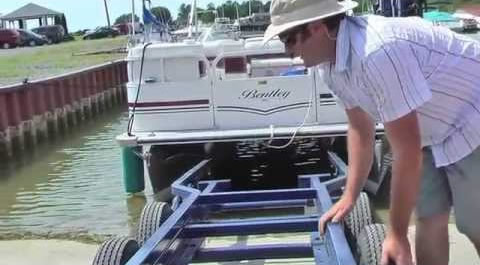
How to launch a pontoon boat by yourself in 5 simple steps
A solo launch can be tough and tricky, but it is doable. Constant practice is what is going to make it easier over time.
Let us look at how you can successfully launch your pontoon boat by yourself.
Before you ease your pontoon into the water you need to get the boat prepared for launching.
1. Preparation steps for a solo pontoon launch
- Disconnect any incandescent light bulb plugs
- Disconnect any electrical outlets
- Stowaway safety equipment, mooring lines and transom straps inside the boat
- Double check to see whether your drain plug is in its right place
- Collect your fenders and mooring lines in readiness for use
- Learn how to back your trailer up in a straight line.
2. Approach the launch ramp
Although launching is easier when there is a person driving and another directing, you can still do it by yourself. Just be aware that the first few times you do it, expect it to may be challenging.
The easiest way you can approach the ramp is by positioning both your pontoon trailer and your vehicle as straight as possible, halting at about a trailer’s length away from the ramp.
3. Back up to the edge of the water
When you have your angles right and in a straight line, back up slowly towards the edge of the water.
Stop when the water is just above the wheels of the trailer.
Once you are in place, park the vehicle.
4. Unhook the safety chain and secure a rope
After you have parked close to the water’s edge, get out your vehicle and approach your pontoon.
Now you can unhook the safety chain and secure an anchor rope to the bow of the pontoon.
The boat is now ready to be released.
Go back to your vehicle with the rope in hand and allow yourself extra line so your boat can drift backward. Keep the rope secured by wrapping it around your hand and pass it through the driver’s window.
5. Begin backing the boat into the water
In a straight line, begin backing up to push the pontoon and the trailer into the water. Let the rope out continuously as you back up.
When you have positioned yourself, hit the brakes and the pontoon will go off the trailer into the water while you’re still holding the rope in your hand. Make sure you have given the boat enough water depth so it doesn’t get grounded.
You can then pull the pontoon back to the dock using the rope, and tie it off to the dock. When you are done, go and park your vehicle and get ready for your pontooning experience.
Final thoughts on trailering & towing a pontoon boat
Towing a pontoon boat is a different experience from towing other things. Pontoon boats are heavy and big.
However, with a bit of practice anyone can safely tow a pontoon using the correct procedure and by following all the right steps. Just allow yourself to take some time to practice towing the boat locally before embarking on an actual journey. You will quickly get the hang of it and should any problems arise you will be close to home making it easier to rectify them.
